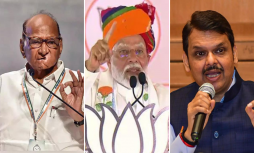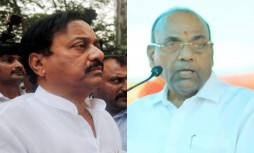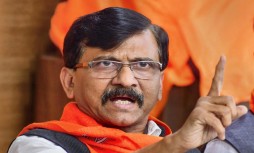Accelerating Highways – The feature of New India
September 15,2020
Glimpse of 4 lane Nayagaon to Satanwarda of Gwalior-Shivpuri Section of NH-46 which was recently inaugurated by Hon’ble Minister of RT&H, Shri Nitin Gadkari ji
NHAI has just released the data of record 3,979 km of highways construction in the concluded fiscal year of 2019-20. The construction pace has seen a steady growth. The feat becomes all the more important, when economy is slowing down due to COVID 19 pandemic. This achievement was possible only because of focus and sustained intervention from highest levels both at administrative and political level.
India has a huge highways sector. As a factual figure, out of roughly 5 million kilometres of a road-web spread out throughout the country National Highway contributes about 1.46 lakh kilometres. India has the second largest road network in the world. Besides, the robustness of the network can be gauged from the statistic that these roads bear more than 60 percent of total goods traffic in the country. In 2014 the Roads sector was under tremendous stress, developers and concessioners were staring at large volumes of NPAs. Large companies were relooking at their strategies about continuing in the Highways sector. NHAI has more than 200 languishing or stalled projects worth more than 2 lakh crores. Hon’ble Prime Minister and Minister for Highways took on this challenge of turning around this wheel. They had clear vision that Road Network is like blood veins of the Nation. The more you strengthen it the more the speed of economic engine increases.
Since 2014 when Prime Minister Modi led government came to power and Mr Nitin Gadkari became Highways Minister, India has seen unprecedented growth and pace of Highway development. Over the last five years, Ministry of Highways has constructed about 40,000 km of National Highways and awarded 60,000 km of National Highways work worth Rs.7,36,000 crores. The National Highways length has been almost increase to 1.5 times from 91,287 km in March 2014 to 1,46,000 km. The average rate of road building activity has been 31 kms per day.

This was possible because of large number of initiatives that have been unearth at grassroot level. Reviving stalled projects, streamlining of land acquisition and acquisition of major portion of land prior to invitation of bids. Along with these initiatives, the change in work culture with steps like award of projects after adequate project preparation in terms of land acquisition, clearances etc, disposal of cases in respect of Change of Scope (CoS) and Extension of Time (EoT) in a time bound manner and close coordination with other Ministries and State Governments have been further accelerating Highway Development. The contractors were given bonus if they complete the work before schedule on every day saved and were penalise on delay of every single day delayed. Fasttrack decision making, transparency in tendering, award and redressal of grievances of all the stakeholders at highest level has been hallmark of this new work culture. Right from shift in work culture, every possible challenge was addressed. Innovation in construction process by more mechanisation, new materials, methods with emphasis on use of new technology, equipment has been giving positive result for Highway sector.
An ambitious Highway Development Program Bharatmala Pariyojna is being undertaken by the Ministry of Road Transport & Highways. The Bharatmala is an umbrella highway development program. It envisions boosting the efficiency of the National Corridor (Golden-Quadrilateral and NS-EW corridor) by decongesting its choke points by lane expansion, building new ring roads, bypasses, elevated corridors and logistics parks. The program consisting of 60,000 kms of Highway Development with first phase includes development of 22500 kms with investment of more than 10 laks crores. This program includes constructing 6,000 km long inter corridor and feeder routes, 2,000 km of border and international connectivity roads, 5,000 km to be upgraded under the national corridor efficiency programme, 800 km of greenfield expressways, 9,000 km under the national highway development programme and 2,000 km of coastal and port connectivity roads.
Bharatmala Phase-I Components
|
Component |
Length |
Expenditure |
|
Economic corridors development |
9000 |
1200 |
|
Inter-corridor & feeder roads |
6000 |
800 |
|
National Corridors Efficiency improvements: |
5000 |
1000 |
|
Border & International connectivity roads |
2000 |
250 |
|
Coastal & port connectivity roads |
2000 |
200 |
|
Expressways |
800 |
400 |
|
Total |
24800 |
3850 |
Source: Ministry of Road Transport & Highways, India
This shall ensure National Highway connectivity to all district headquarters. Addressing 185 choke points on National Highways, 28 ring roads, 45 bypass and 34 lane expansion projects. Rs 11,000 crore have been allotted to rectify 726 Black Spots which were most accident prone. Under Sethu Bharatham, 208 RoBs/RuBs are under construction over railway crossings making all national Highways crossing free. About 1500 old bridges are being repaired. With the help of IBMS (Integrated Bridge Management System), 172517 bridges data base has been built. With the help of this data base, all the vulnerable bridges were identified and repairs have been initiated. Roads in the hilly states have been strengthened by use of cross barriers to prevent road accidents.

According to Mr Nitin Gadkari, Minister Road Transport & Highways, the programme has been designed to bridge the gaps in the existing highways infrastructure so as to the movement of man and material more efficient. Bharatmala will grant India 50 national corridors as opposed to the six right now. With this, upto 80 per cent of freight shall travel along the Indian National Highways as against the 40 percent at present. The project shall connect 550 districts in the country through the National Highway linkages against the existing number of 300.
All these are promising for the future of Indian roads sectors as well as the country’s economic growth. The impact of this Highway Development is being experienced by commuters with a higher speed of traffic flow on key corridors. This will further improve since uniform four-laned roads are provided between the identified points. Each of these corridors is expected to be short on length and access-controlled particularly on greenfield corridors for faster freight movement. The objective is to eventually reduction in logistic cost for the industry by building new roads and facilitating smooth mobility on existing ones. This shall not only ensure for free and fast flow of material for the Industry but shall also help them make globally competitive paving way for more and more foreign companies looking at India as preferred investment destination. The ultimate aim is to make an Indian truck to travel 700-800 kilometers daily, as compared to present level of 250-300 kilometers per day. Government has also rolled out smart-tag based e-tolling to end delays at toll plazas. The NHAI is also taking extraordinary steps like facilitating online sale of FASTags and offline sale through Common Services Centre (CSC) near toll plazas.
The Highway Development has huge potential of generating employment. A rough Estimates suggest that under BharatMala employment for 500 million man-days will be generated. This would be mean average of nearly 125 million man-days yearly from 2018-2022. This man days shall generate employment for professional, engineers, appox 35 million skilled labour man-days and 80 million semi-skilled and un-skilled man days. The cascading effect shall lead to generation of indirect employment opportunities also.
In the second term of Modi government, the focus is clearly on to further step up the good work that has been put up in Highways sector. Vision is to build next generation of highways and expressways to reduce travel time and enhance user experience. It has been proposed to complete around 3,000 km green field expressways. Most prominent being the Delhi-Mumbai Expressway for which construction has commenced and an ambitious target of finishing it by 2022 has been set. Delhi-Vadodara Expressway will be a 8-lane facility which will reduce the distance between Delhi and Mumbai by 150 km. Making sure no budgetary or financing constrains create any hurdle for these ambitious projects, Apart from toll revenue, Bonds and bank debts. New innovative financing models such monetisation of NHAI assets and securitisation of each project through SPV route are being taken up. NHAI has raise funds through rupee denominated bonds (Masala bonds) and InvIT.

Positive and constructive approach, social sensitivity and strong political will has immense energy to make every impossible possible. Prime Minister Modi led this government has displayed this in plenty in all sectors of governance. Road sector is playing pivotal role in creating world class infrastructure for India. In conclusion, this shall not only change the face but also ensure new and bright future for New India.
-
Vaibhav Dange





















